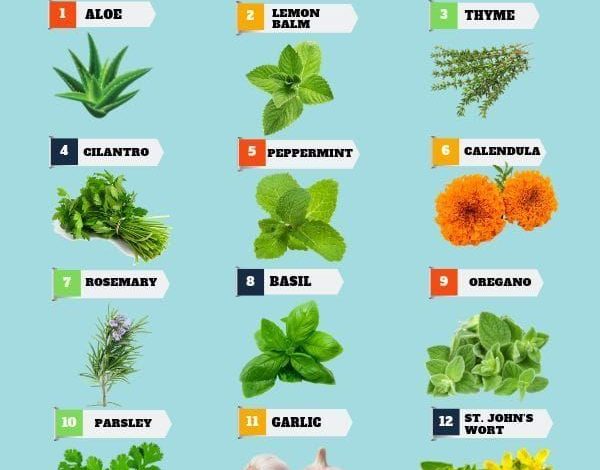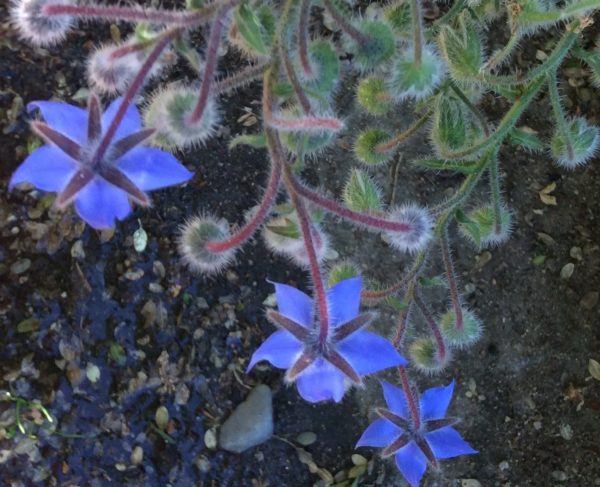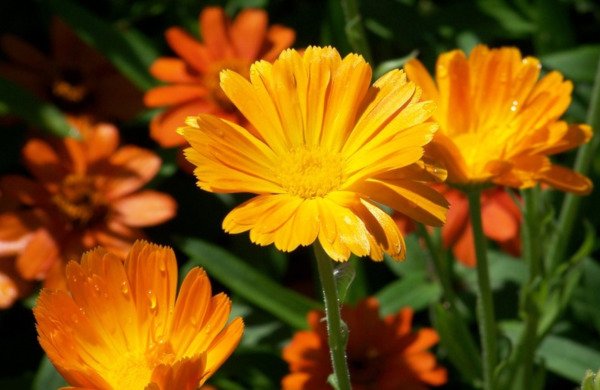Medicinal garden: 10 beneficial plants that help us

If you want to set up your own medicinal garden today we will see some beneficial plants for health and also to help solve some problems of pests and diseases that can arise in the organic garden.

Some of these plants from the medicinal garden that we will see today can be used to make natural preparations that help us improve different ailments (such as conjunctivitis, diarrhoea, gas, vomiting, colds…), and some, in addition, are also plants beneficial because they are used to prepare home remedies for the protection of the orchard or to improve some aspects of the crop.
10 plants for the medicinal garden. beneficial plants
Clover
It is a very useful plant in the organic garden because it can be used to make green manure, a natural organic fertilizer that will help you nourish the garden soil naturally.
Clover is also used as a medicinal plant: if its flowers are prepared in an infusion, an effective eye drop is obtained against conjunctivitis and other inflammations of the eyes and eyelids. Make an infusion with 20-30 grams of clover flowers (previously crushed) in a liter of water and, when it is cold, wash your eyes with it.
Basil
In addition to being a delicious ingredient for many kitchen recipes, it is one of the most useful beneficial plants in organic gardens due to its use against the most typical pests, such as whiteflies, which it repels with its smell.

But everything does not end there, basil has important health benefits, in traditional medicine flowering basil is used to make infusions against vomiting and nausea typical of pregnancy. This infusion is also good for gargling to cure sore throat.
Basil is easy to grow, even in small pots or planters. If you want some tips to learn how to grow it at home, take a look at this post I wrote about « How to grow basil «.
Garlic
It is one of the most used plants to make natural remedies against pests and diseases in the garden and also one of the most common healing plants, so it is essential in a medicinal garden.
Among its best-known medicinal properties, its effectiveness against digestive conditions stands out, such as stomach problems. Garlic helps to secrete gastric juices and favors the elimination of gases. It is antimicrobial, so it will help you with respiratory or digestive problems when you have some type of bacteria. It is also used to improve circulation, including for acne problems.
An increasingly well-known and very beneficial remedy for many ailments is black garlic, a way of preparing this plant that multiplies many of its healing and beneficial properties for health.
Turnip
Turnip decoction is very effective against colds. Peel the root and cut it into a few pieces, then cook it and, when the pulp of the turnip is soft, strain it and drink it warm with a teaspoon of honey.
Horse tail
Like garlic, horsetail is one of the most common plants used to prepare natural remedies against garden pests and diseases. It is used to treat diseases caused by fungi and to eliminate common garden pests such as slugs and snails, aphids or red spiders.

Horsetail can also be used to make natural agricultural biostimulants, preparations that help garden plants grow stronger and more vigorous.
In addition to all this, horsetail is a well-known plant that will be very useful in the medicinal garden due to its beneficial properties for health. One of its best known uses of horsetail infusion is as a diuretic and purifier of the body, an additional remedy to diets that can help a lot in weight loss. But horsetail has other traditional uses. It is used, for example, to stop nosebleeds or to heal ulcers or bleeding sores.
Borage
It is a useful plant in the garden because, in addition to making it look prettier, it favors pollination and, if it is placed next to plants such as tomatoes or pumpkins, it helps enhance their flavor and repels some typical pests. Some farmers also recommend it to make green manures for soil fertilization.
It is also interesting because it is a wild plant for cooking, perfect for a more original menu. The leaves and stems of borage can be cooked, for example, in soups or scrambled with eggs (as is done with spinach or young garlic), and can also be eaten raw in salads. The flowers are often used to decorate desserts or infused to give a special touch to drinks.

One of the best known medicinal uses of borage is the preparation of infusions to combat colds.
Sage
Its leaves are used in the kitchen to flavor soups, sauces, rice dishes, roast meats… Sage is also used in infusions for its beneficial properties for the body.It is used, for example, to stimulate digestive functions: for difficult digestion, diarrhoea… and also for asthma, chronic cough, to reduce menstrual cramps or to treat sores and ulcers, among other things.
Dock
Sorrel is another of the basic plants of the medicinal garden, it has been used for centuries for its beneficial properties for health. Its leaves are used, for example, as a natural remedy against anemia, since they are an important source of iron and vitamin C. They have a very characteristic flavor (like vinegar) so they go very well mixed with other types of leaves in salads.
Its roots and seeds can also be used to make diuretic infusions and against skin infections.
Calendula
This plant is useful in the garden because its yellow or orange flowers attract beneficial insects such as ladybugs, predators of aphids, and it also serves to repel other microorganisms that cause plant diseases: nematodes.

In addition, it is one of the most widely used edible wild plants in the kitchen, its flowers can be a good substitute for saffron (as they give color and flavor), and they are also used raw in salads.
Calendula is another of the beneficial plants for the medicinal garden since, in addition to these uses, it has other applications. For example, it helps prevent and cure intestinal disorders (it goes very well for stomach cramps and vomiting), and it can also be used to prepare an effective ointment against skin rashes, burns or hemorrhoids.
Aloe vera or Sabila
This plant is one of the most used to prepare remedies that accelerate the healing of wounds and burns. It is also very effective for the removal of marks and scars on the skin, although it is effective in this regard only if the plant is old enough, it must be at least two years old.
In addition, it has other health benefits, such as helping to strengthen the immune system, curing digestive problems (such as irritable bowel) or purifying the body.
Other beneficial plants for the medicinal garden
These ten plants that we have seen are just some of the useful plants for the medicinal garden, but there are many others.
I have a very interesting (and very old) book on medicinal plants, and some of the most common healing plants that appear in it are, for example: wormwood, artichoke, poppies, celery, mugwort, milk thistle, dandelion, juniper berries, eucalyptus, strawberries, fumitory, nasturtium, grass, lemon verbena, lavender, mallow, chamomile, lemon balm, mistletoe, nettle, peony, rhubarb, tamarind, valerian…
Do you know other healing plants or beneficial plants for the medicinal garden or do you have experience in the use of any of these? If so, you can make all the contributions you want in the comments below!

![Photo of Oregano Cuttings: [Grafts, Time, Rooting and Planting]](https://www.complete-gardening.com/wp-content/uploads/2022/08/oregano-cuttings-grafts-time-rooting-and-planting-390x220.jpg)

![Photo of 25 Fast Growing Plants: [Types, Characteristics and Images]](https://www.complete-gardening.com/wp-content/uploads/2022/08/25-fast-growing-plants-types-characteristics-and-images-390x220.jpg)
![Photo of Laurisilva: [Cultivation, Irrigation, Associations, Pests and Diseases]](https://www.complete-gardening.com/wp-content/uploads/2022/08/laurisilva-cultivation-irrigation-associations-pests-and-diseases-390x220.jpg)